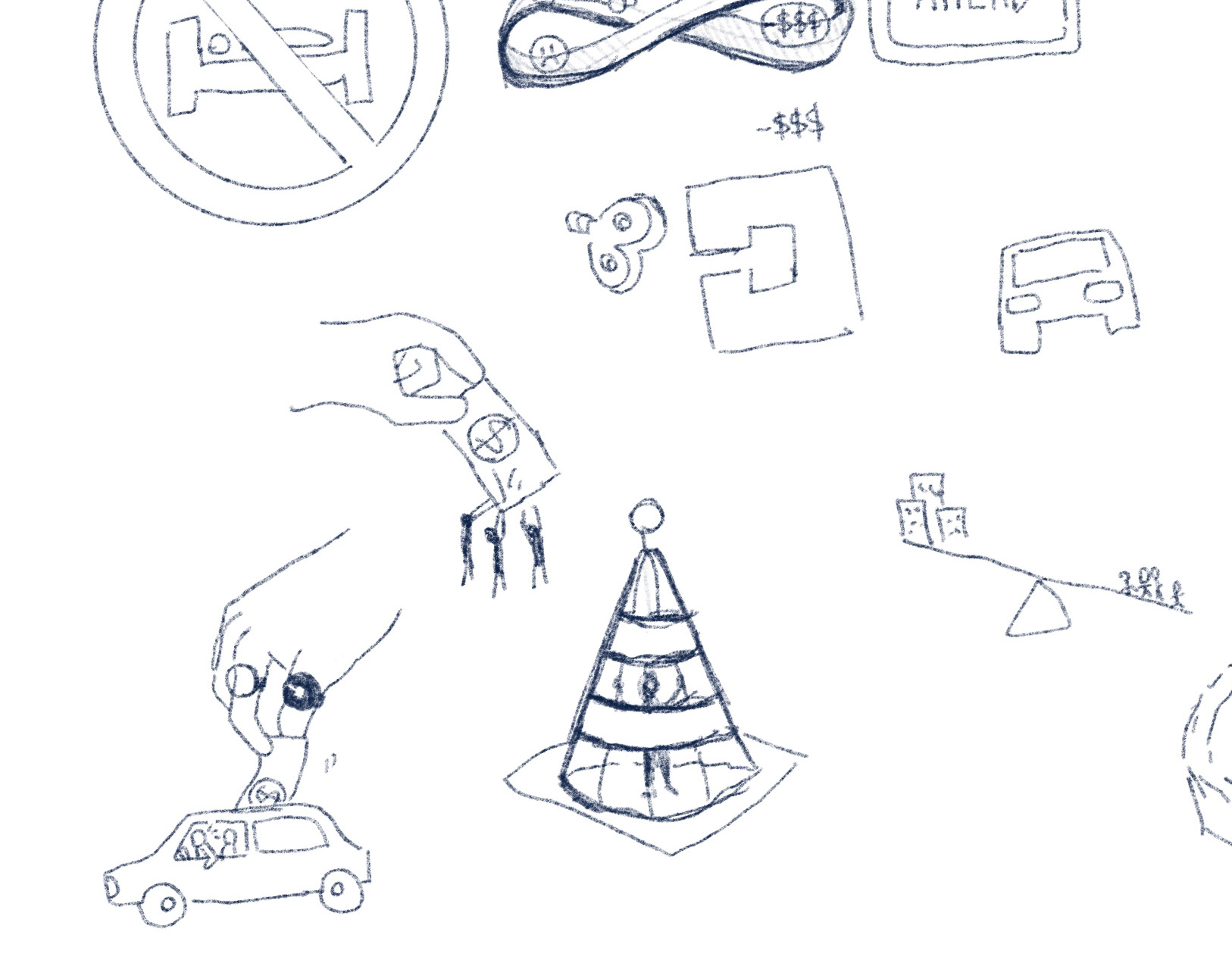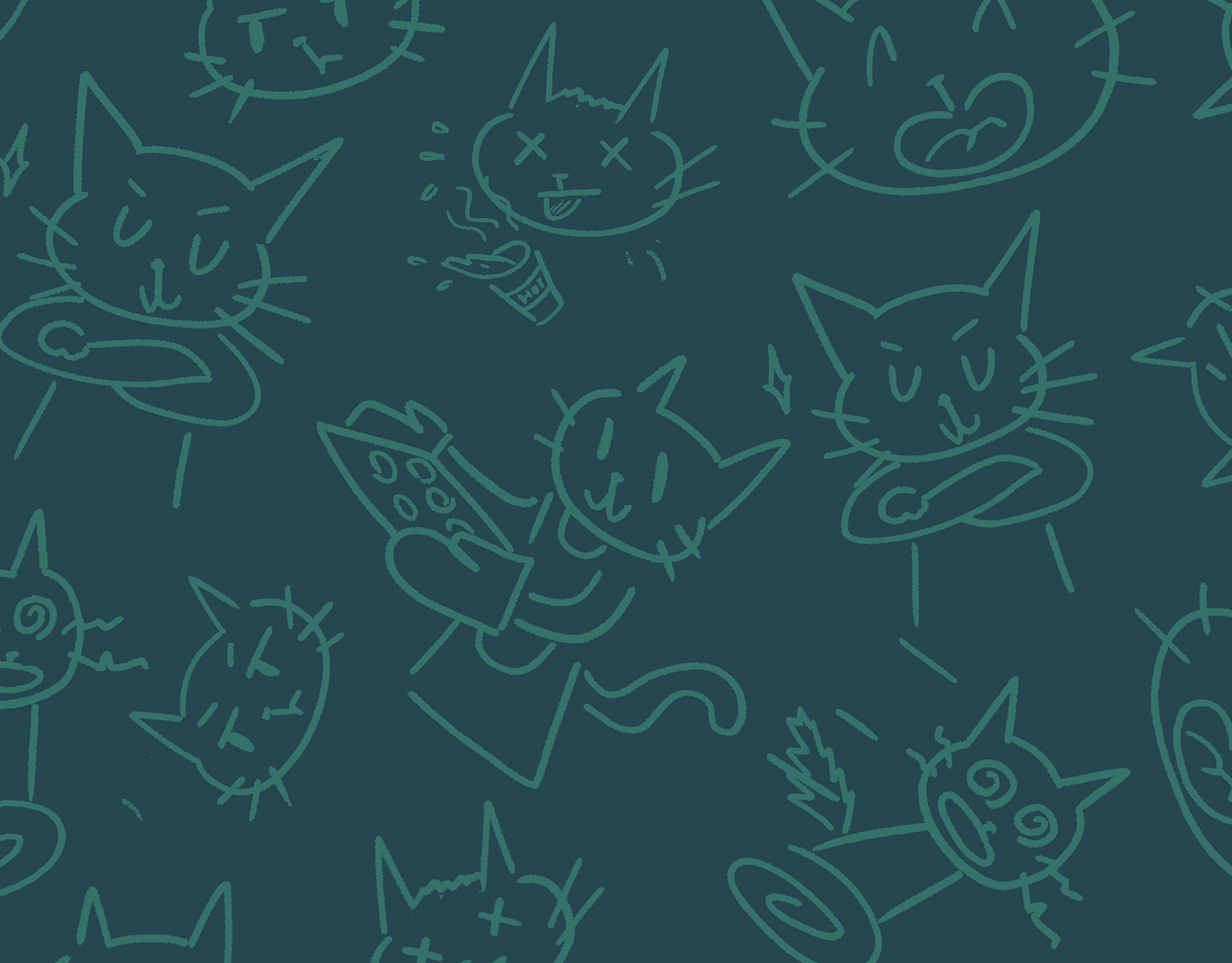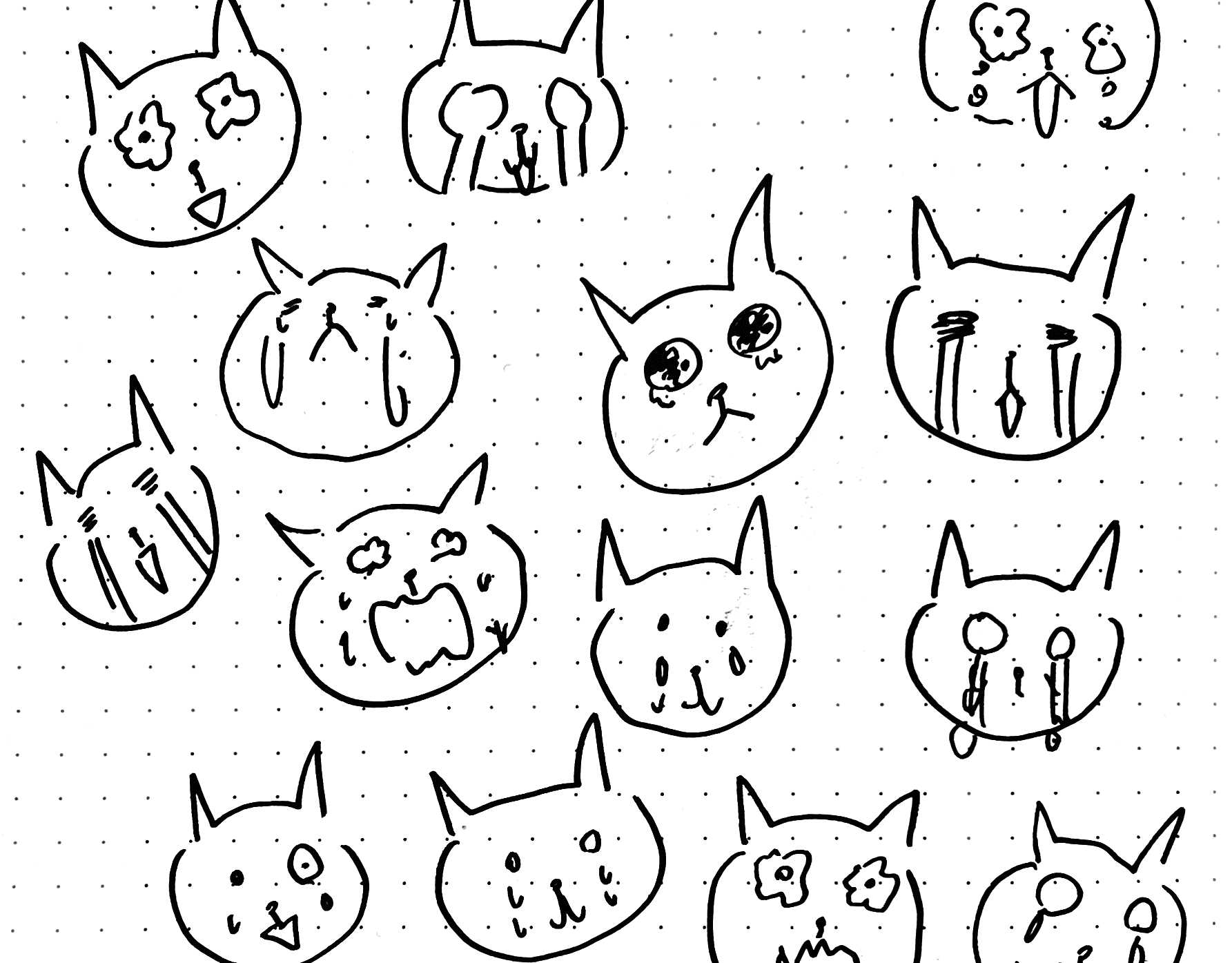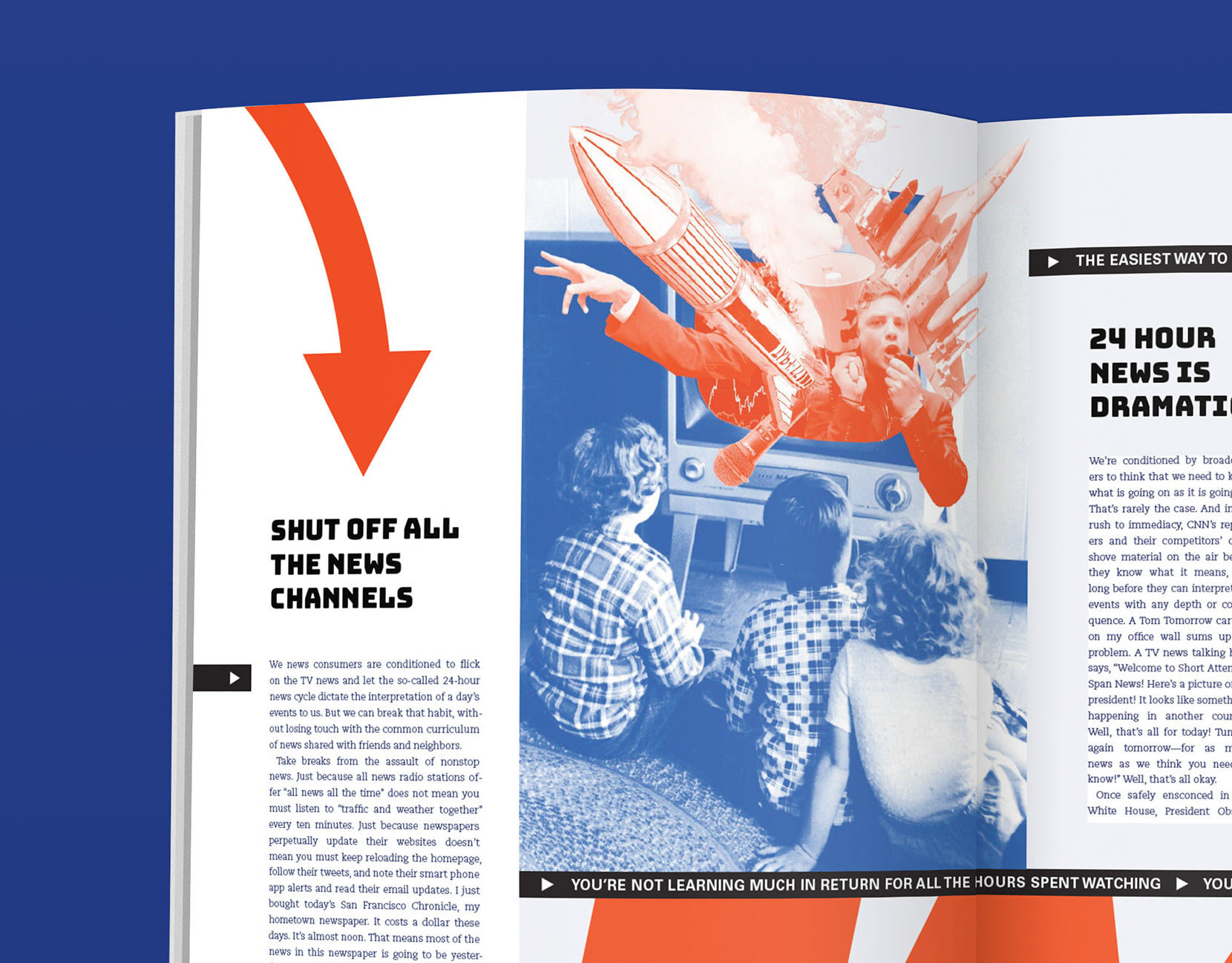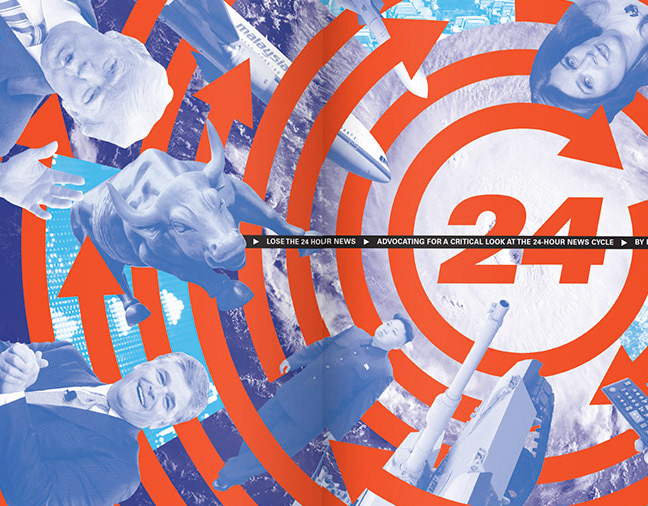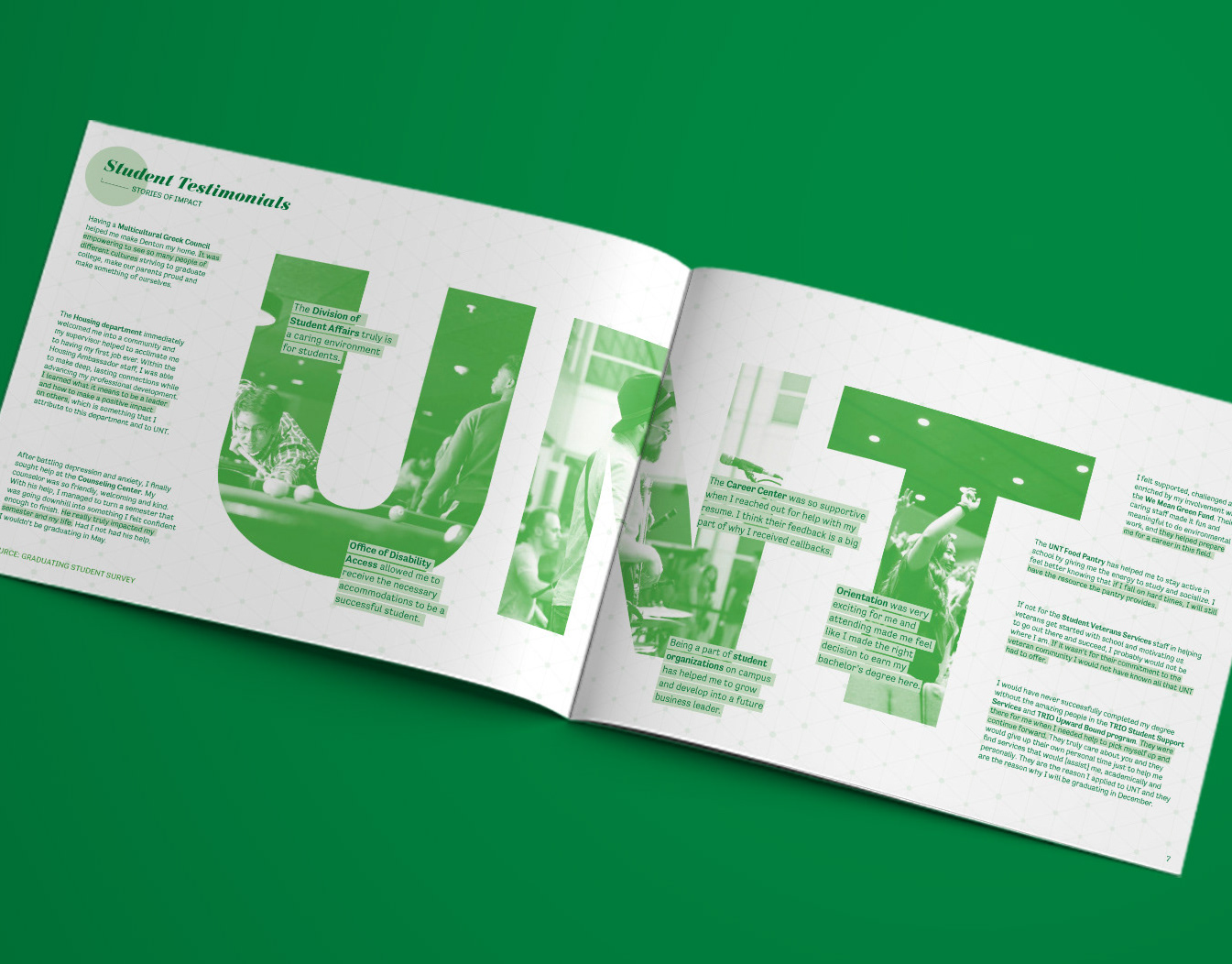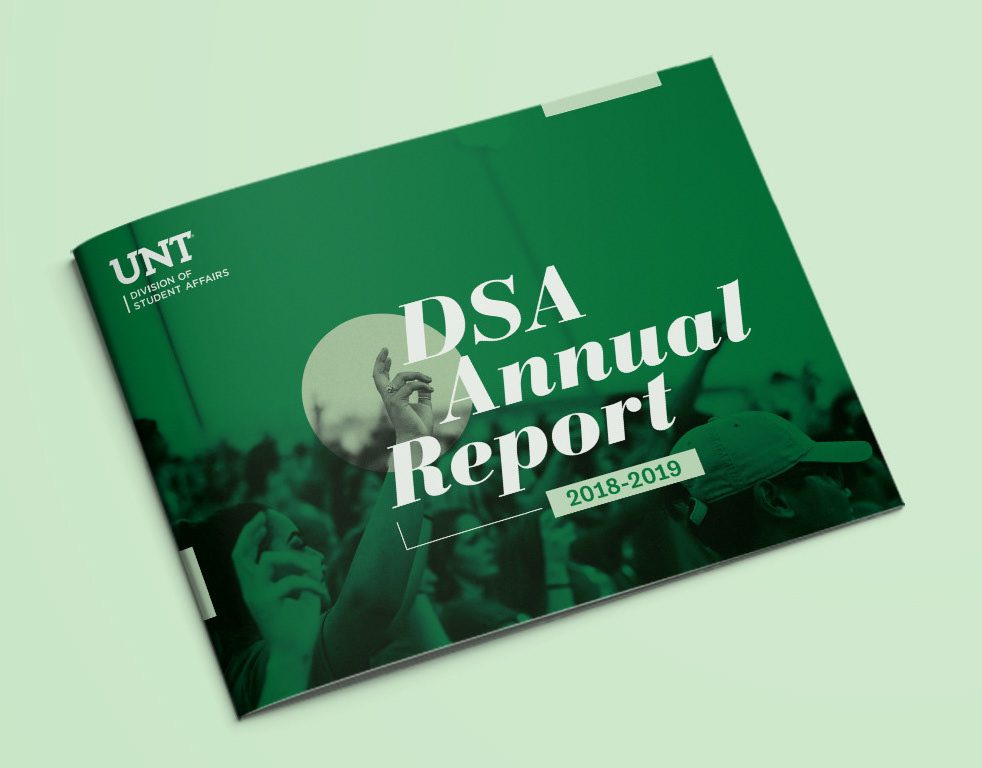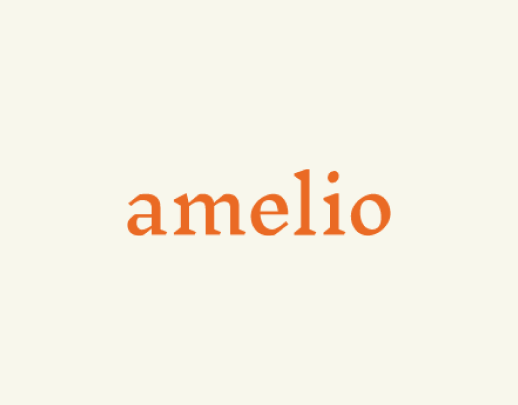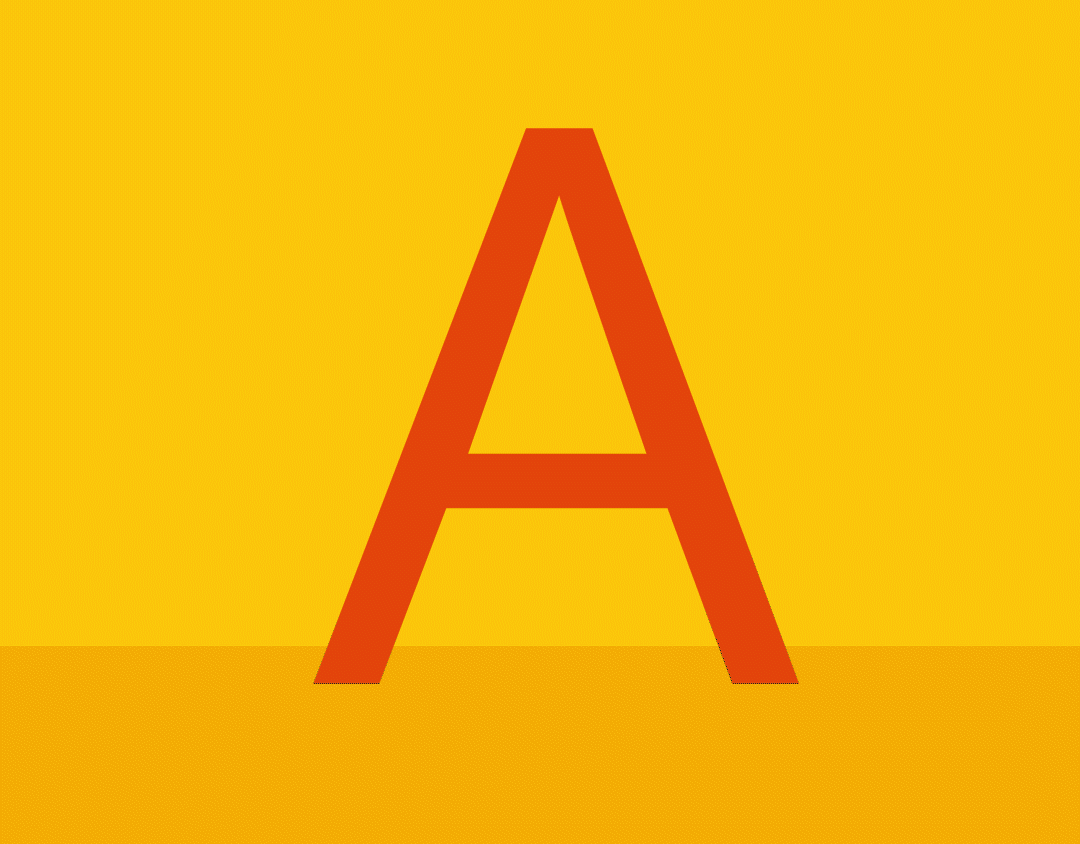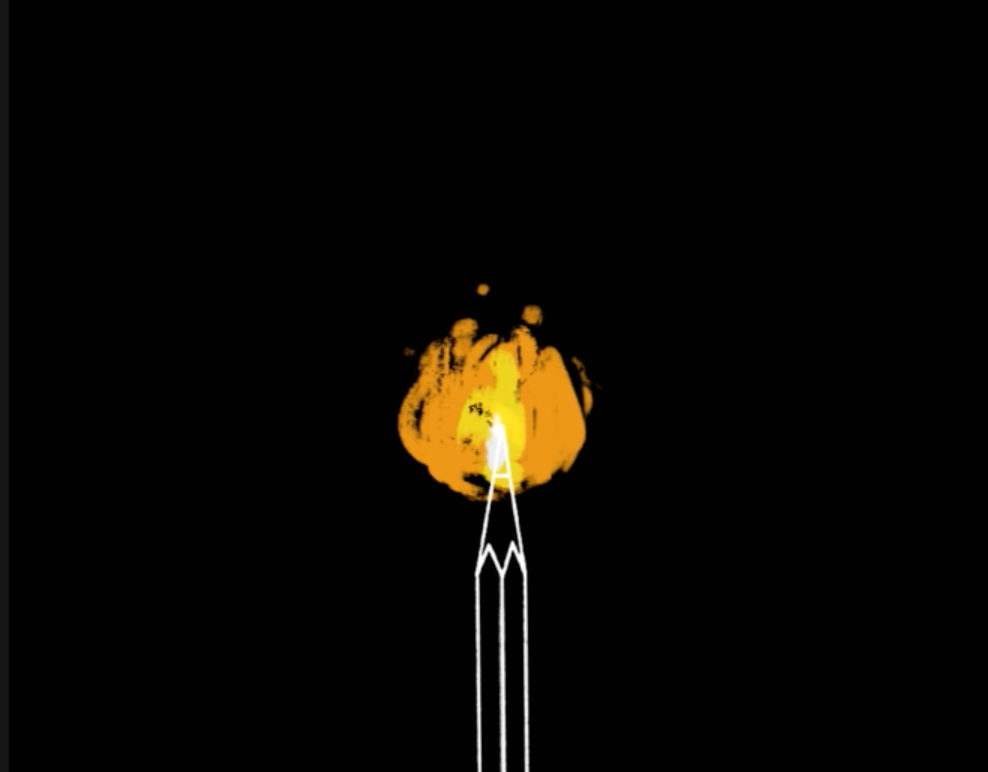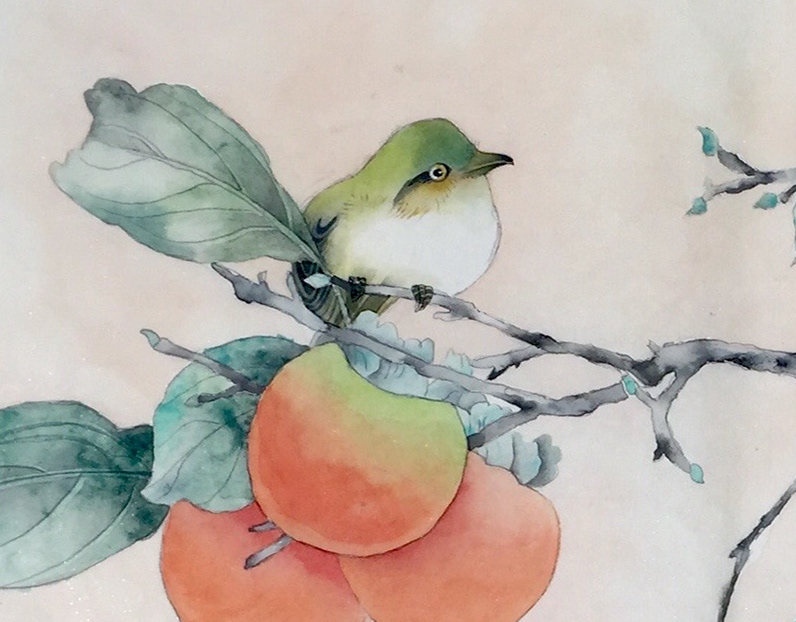In Spring 2022, my cohort and I worked on an eight-week project to create an innovative exhibit that tells the story of NASA’s Astro-1 mission at the Smithsonian. We worked with retired NASA scientists engaged in the Astro Restoration Project to better understand Astro-1 and envision an innovative, engaging science museum experience.
As a result of our hard work, we generated 13 storyboards of experiencing the Astro-1 exhibition that's meant to:
- Inform visitors about science concepts (related to UV and X-ray generally) and Astro-1 (specifically)
- Engage the human senses of museum visitors
- Spark curiosity in museum goers
About this project:
Facilitators: Prof. Brian Sullivan and Prof. Cassini Nazir
Collaborators: Prof. Ruth West and her class,
Stakeholders:
[Retired NASA engineers] Mike Haddad, Elaine and Richard Hamner, and Maynette Smith.
[Retired NASA engineers] Mike Haddad, Elaine and Richard Hamner, and Maynette Smith.
Tools Used: Mural, Slack, Figma, Keynote, Google Slides, Adobe Suite, and Google Forms.
My Contributions:
Designed and administered museum experience surveys to obtain rich insights and understand different museum visitors' motivations.
Spearheaded the research synthesis and layout design for our 6 unique spectrum-based museum visitor personas.
Illustrated 2 storyboards to bring our big ideas to life.
Captured our research and design process through 500+ photographs and time-lapse videos.
A time-lapse video of an in-progress critique session during class.
1. Explore Uncharted Territories
Diving Right Into the World of Astro-1
To design for an Astro-1 exhibition, we started with rigorous research activities that encompassed the history of Astro-1, the significance of this mission, the science of UV and X-ray, and what Astro-1 discovered and achieved.
The “Astro Observatory” was developed as a system of telescopes consisting of 3 ultraviolet (UV) telescopes and 1 X-ray telescope.
Astro-1 History Key Findings
My team was specifically in charge of researching the history of Astro-1, and here are the key insights that I helped uncover:
- Astro-1 was the first space mission that was exclusively dedicated to astronomy.
- 4 years before Astro-1 launched in 1990, the Challenger space shuttle exploded 73 seconds after liftoff in 1986. The accident devastated NASA's and the public's faith in space travel.
- Originally scheduled to launch right after Challenger, Astro-1 was postponed, and NASA implemented several actions to ensure its safety.
- Astro-1 had to succeed. And it did.
By taking simultaneous observations, Astro-1 was able to look farther into space than ever before and gave the world a reason to dream again.
Composite View of the Crab Nebula. Images like this can’t be captured from Earth because there is far too much interference. They can only be captured from beyond our atmosphere.
Interviewing NASA Engineers
Besides performing secondary research on the history and impact of Astro-1, our cohort also interviewed several NASA engineers who shared insights into Astro-1’s mission.
My teammate Jasmin Yearby, Kris Ma, and I had the pleasure of interviewing Maynette Smith, who worked on the Safety and Mission Assurance of Astro-1 project. She expanded on the masterpiece of engineering to be involved.
Our team interviewing Maynette via Zoom.
"To point from an object moving at 17,000 miles an hour around the earth and compensate for that movement... then point it towards a region in space and get data, is a masterpiece of engineering!"
–Maynette Smith, Retired NASA Safety & Mission Assurance Engineer
2. Empathize with Our Users
One of the empathy immersion activities that we did was to visit the Dallas Museum of Illusions wearing glasses smeared with Vaseline to simulate what it might be like to interact with the exhibit with impaired vision.
Besides understanding the Astro-1 mission itself, we also needed to understand for whom we are designing this museum; in other words, our users. Here are some research activities that I, along with my cohort, performed:
- Empathy immersion activities helped me empathize with different disabilities and design a more accessible museum experience.
- Contextual interviews with museum-goers and staff at science museums.
- Synthesized my findings from 6 existing research sources on museum visitors' experiences and motivations.
- 20+ interviews with different types of museum-goers and stakeholders.
Contextual Interview Survey
To understand our users better, my team and I visited the Fort Worth Museum of Science and History to interview museum-goers and staff while documenting our own experiences at the museum.
Literature Review
In addition to our primary research, I was also in charge of developing the personas for the Astro-1 museum experience. Along with my classmates Jasmin Yearby and Saami Wally, I dug through existing research on museum visits, synthesized our findings, and developed 6 unique and multi-dimensional personas.
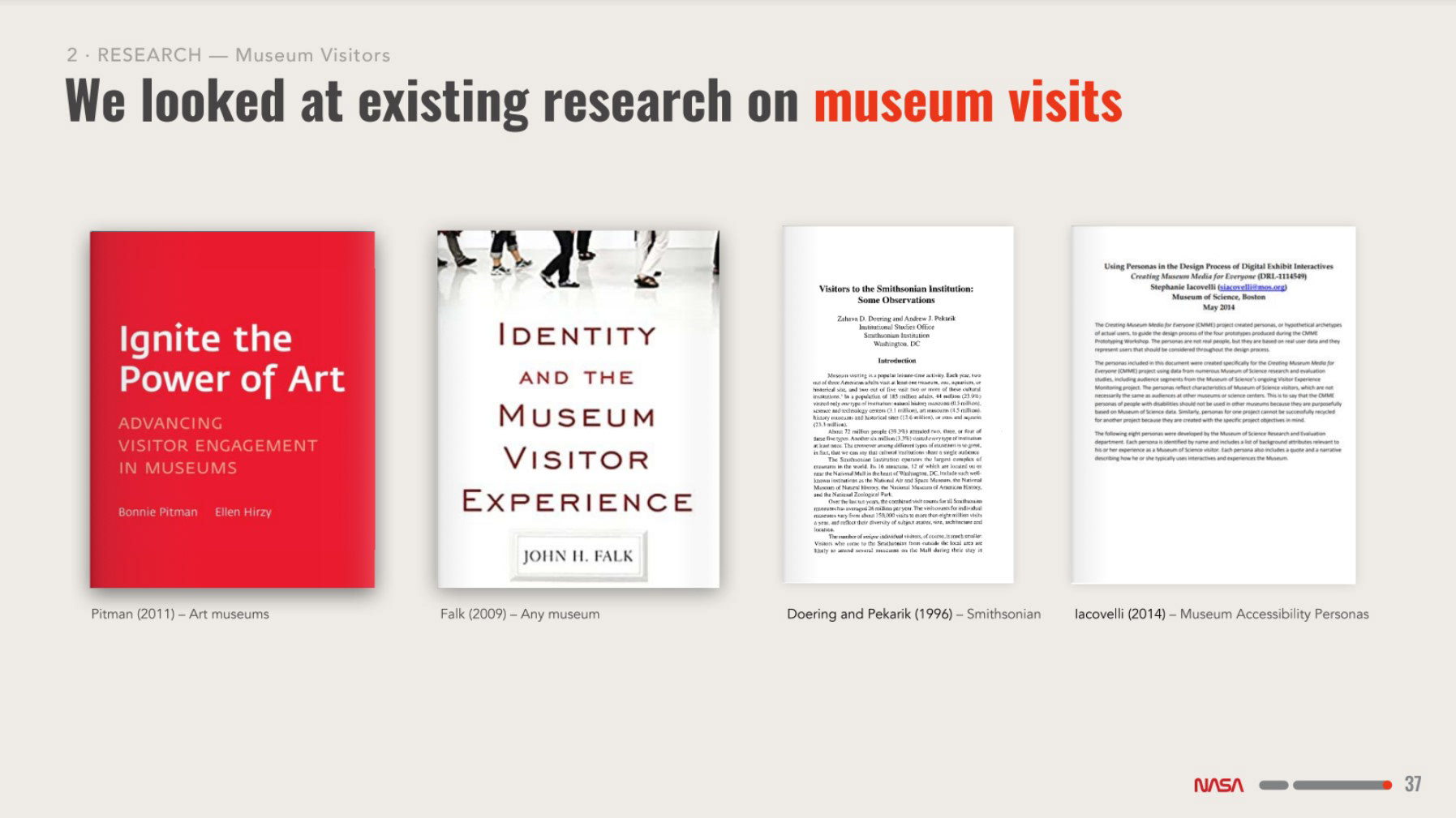

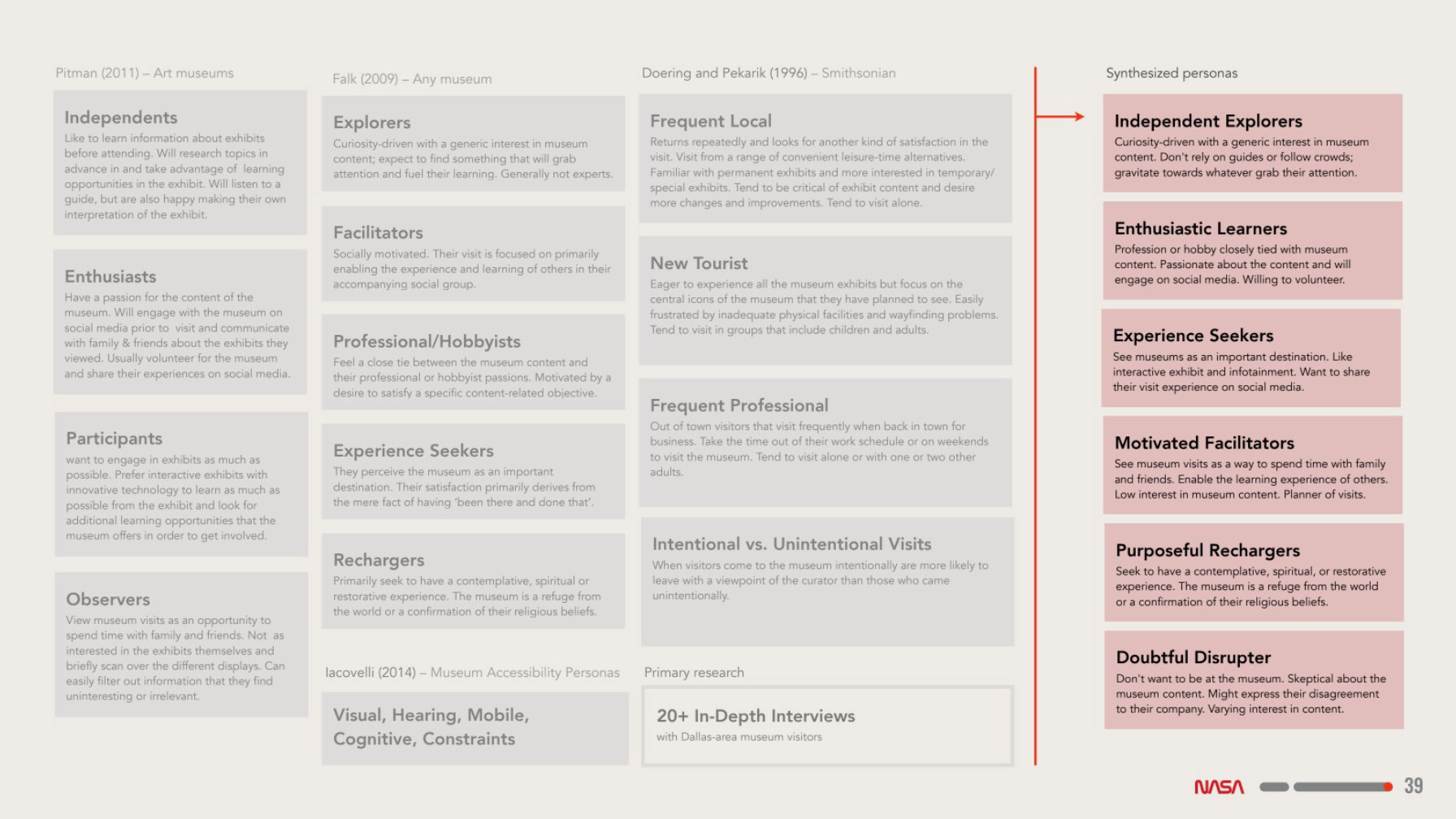
"Museum going is a complex and deeply personal experience that is connected to our individual sense of identity"
Persona Spectrum System
Typical persona research involves one-dimensional findings of a specific user group that doesn't address the fluid and overlapping nature of the user's motivations and goals. That was not enough for us. So, we developed a spectrum system that sheds light on the unique motivations and goals that each of the 6 persona supersets has under different circumstances—for example, visiting alone vs. visiting with family, as a local vs., as a tourist.
To see more details of our personas, click on the button below and navigate to page 114.
Service Design Blueprint
The Service Design Blueprint covers different stakeholders at a given service design project, their actions, pain points, and untapped opportunities at each stage of the service. View the full Service Design Blueprint here.
Huge shoutout to Rocio Diaz for tackling the design and digitization of our Service Design Blueprint. We had 16+ internal stakeholders, 40+ museum-related activities, and 50+ touchpoints and interactions in our initial blueprint draft. Rocio and her team did a great job organizing and crystalizing our draft in a quick turnaround.
Focusing on the User's Journey
While the Service Design Blueprint gives us a bigger picture of all the front-end and back-end users, actors, and stakeholders involved in a service design, we also developed a museum goer's Journey Map that detailed the different actions that they might take at different stages of a museum experience.
Combining that with our personal research, we identified pain points, gaps, and opportunities that help inform our designs to serve all types of museum-goers.
In total, we had...
350 + hours on research and co-creation activities
32 different museum visits
264 big ideas generated
13 final storyboards
3. Envision a New Experience
Co-Creation and Idea Generation
Well-informed by our research activities, we dived into generating big ideas to envision innovative ways of experiencing an Astro-1 museum experience.
We performed 3 workshops with more than 30 people for this project. We explored new technology such as AR/VR, uncovered new ways to visualize data, and much more.
This led to over 250 big ideas and informed our creative envisioning process.
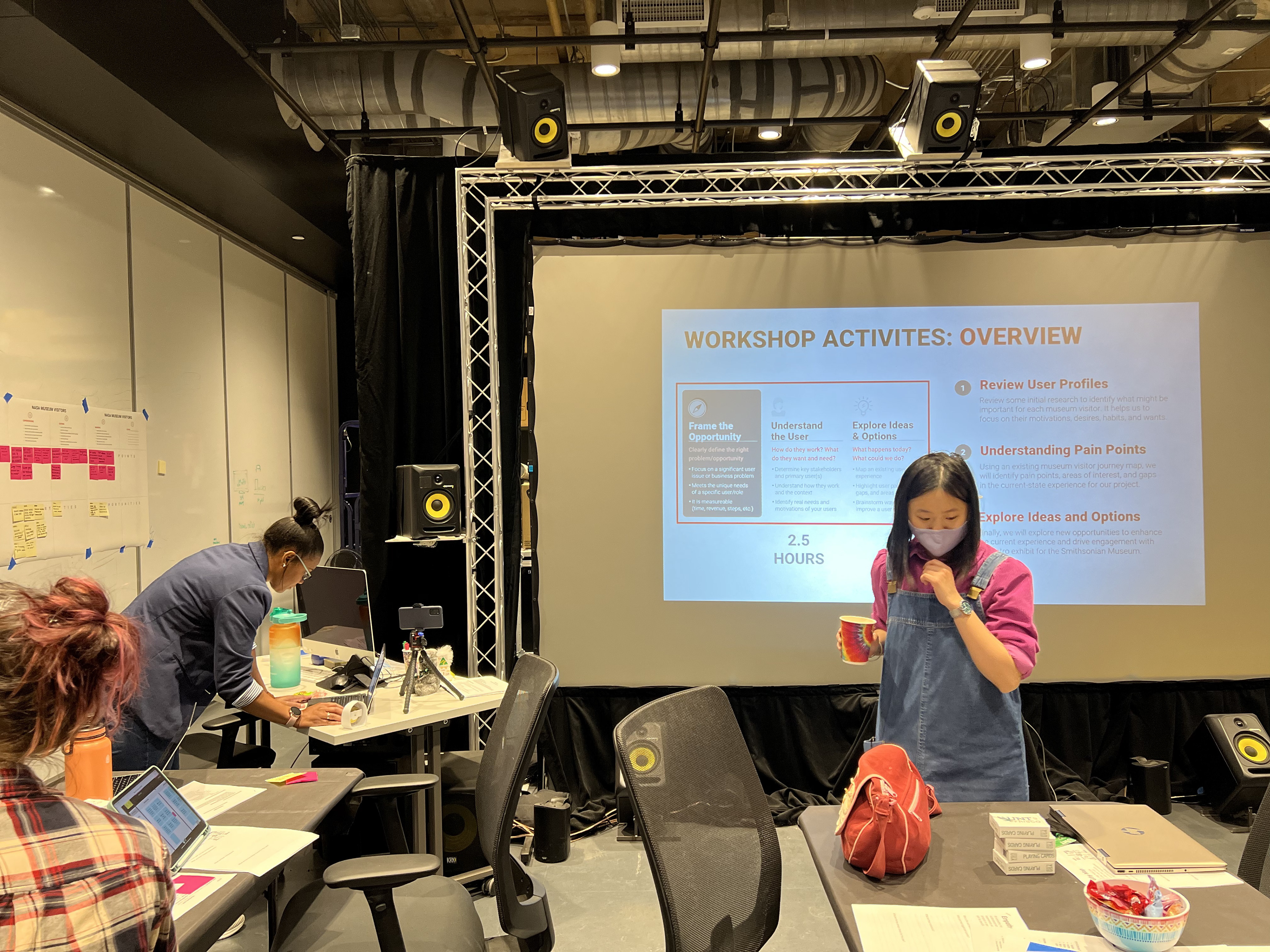
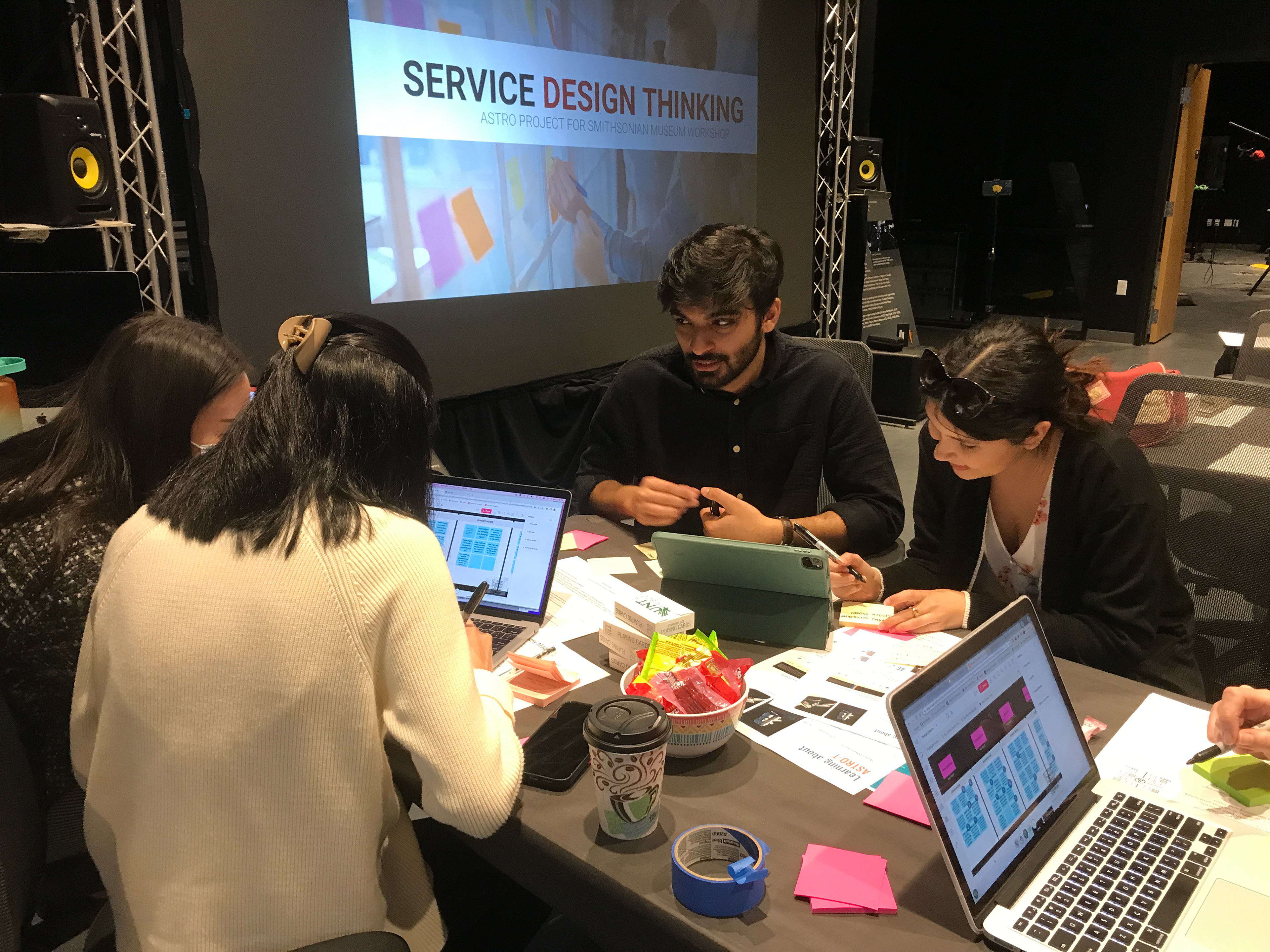
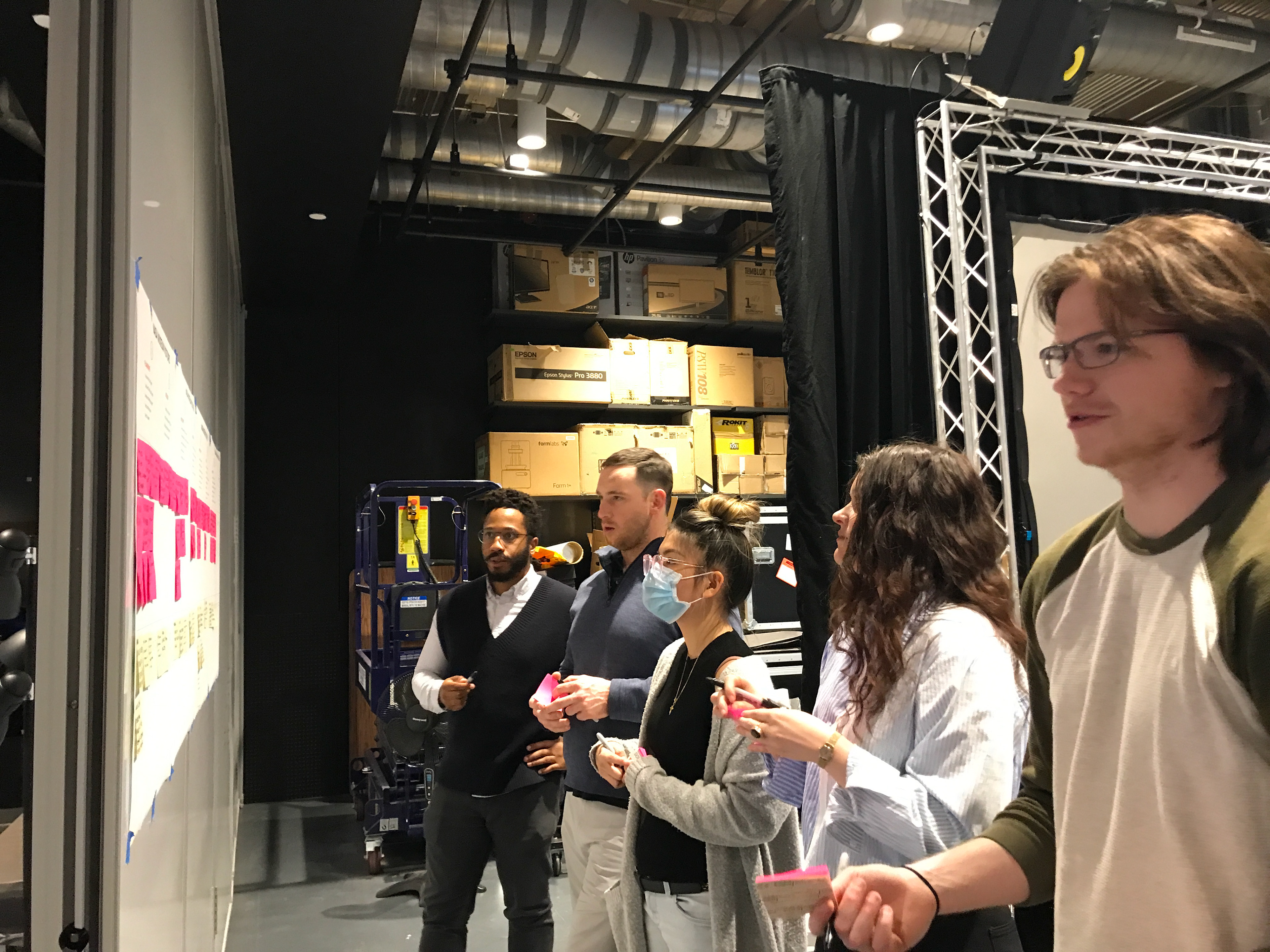
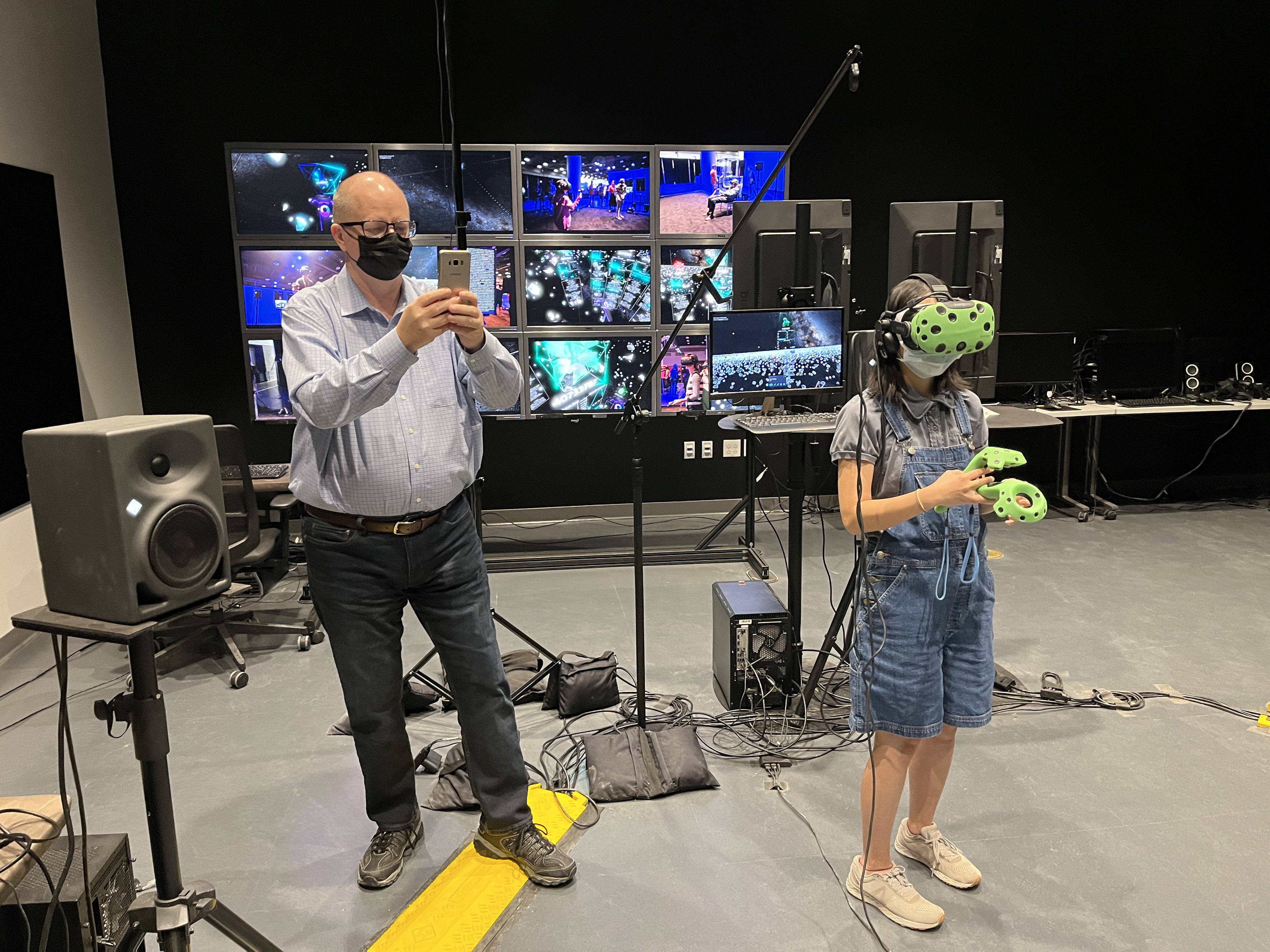
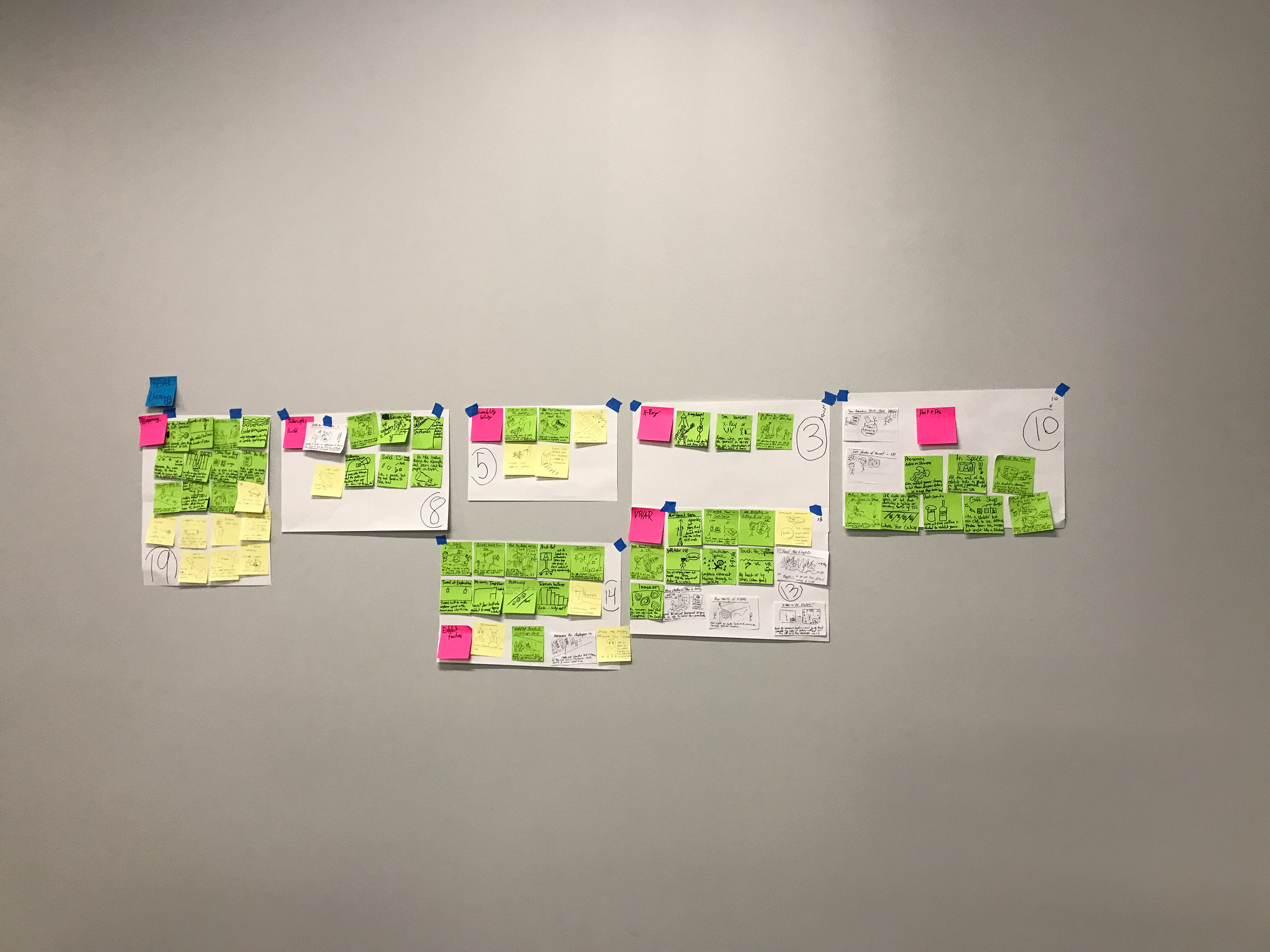
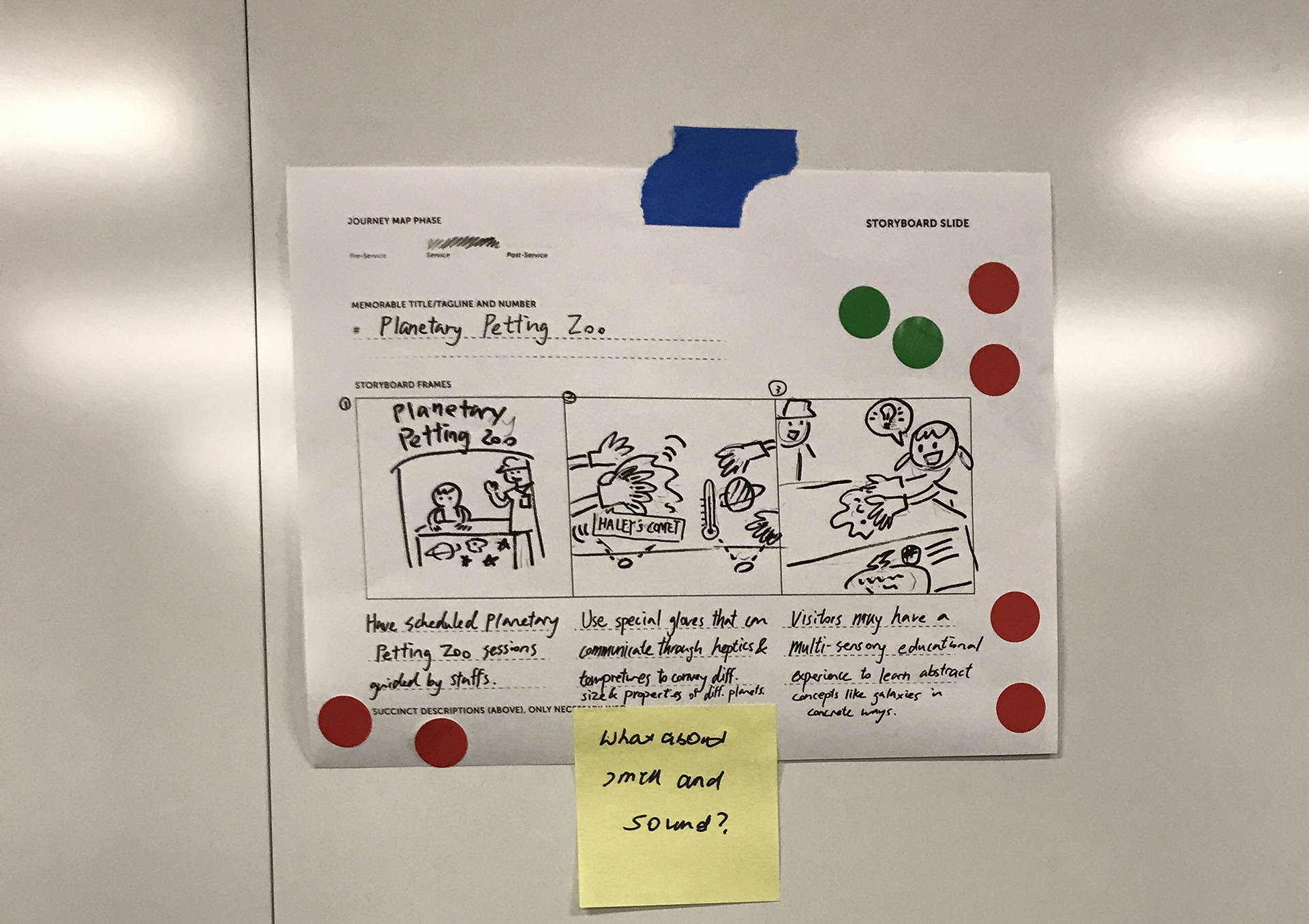

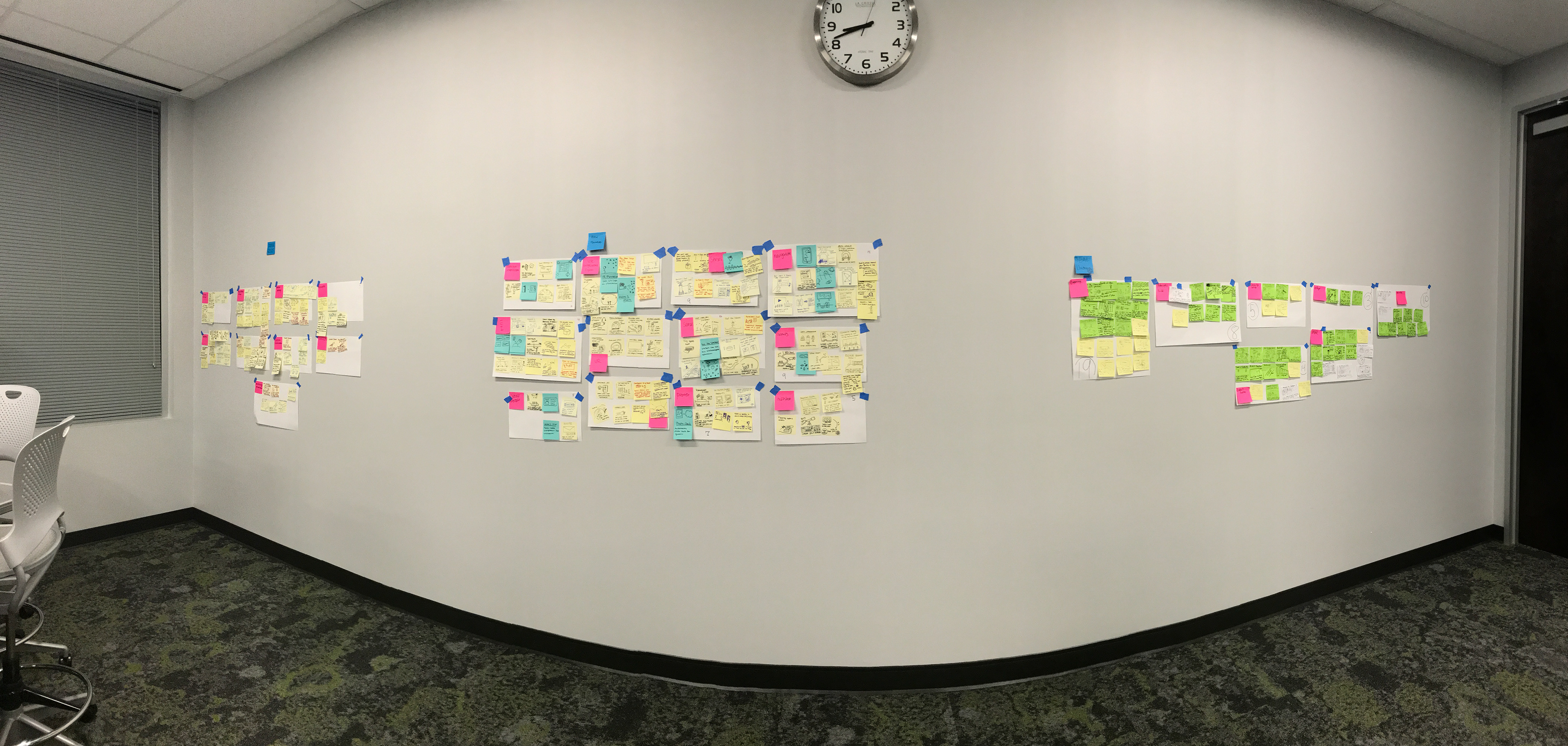
13 Hand-Picked Storyboards
We did a lot of user research and what we present here is the feedback from our research and design participants; it's not ideas based on mere assumptions.
All the storyboards you’ll see will make the invisible interesting, immersive, meaningful, felt, and delightful.
Amongst our 13 hand-picked storyboards, I illustrated 2 sets of storyboards, A Tapestry of Discoveries and Astro-1 Docking Station.
2 of my Big ideas, Inside Out and Planetary Petting Zoo were upvoted repeatedly in multiple rounds of critiques. After some adaptation and combination with other concepts, they emerged as part of the top 13 ideas selected for storyboard illustration from a pool of hundreds.
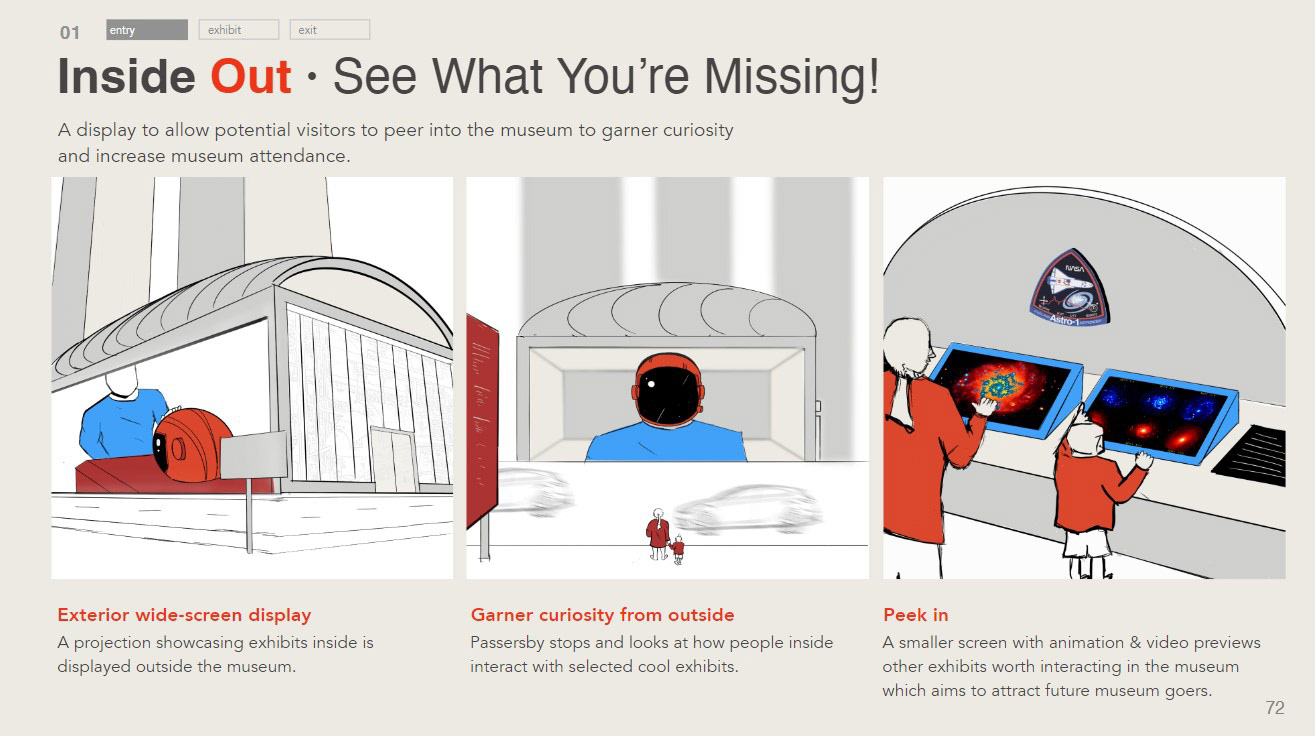

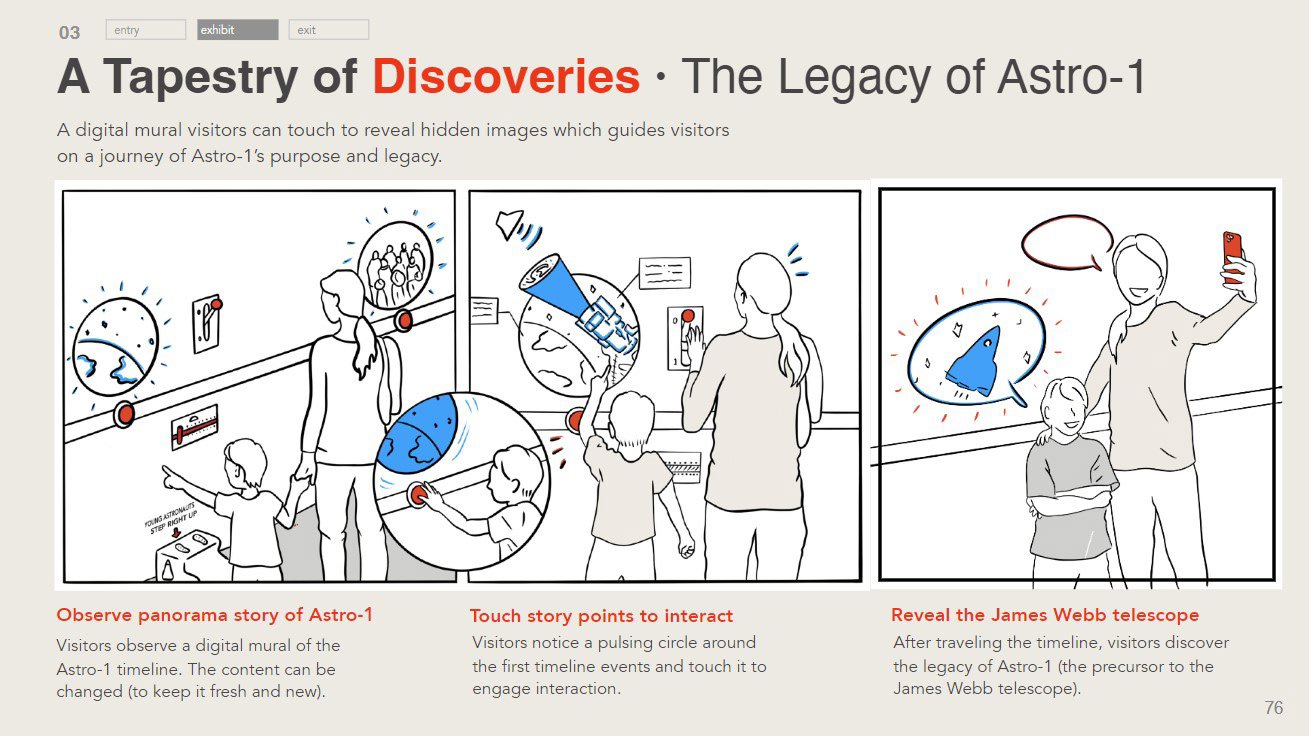
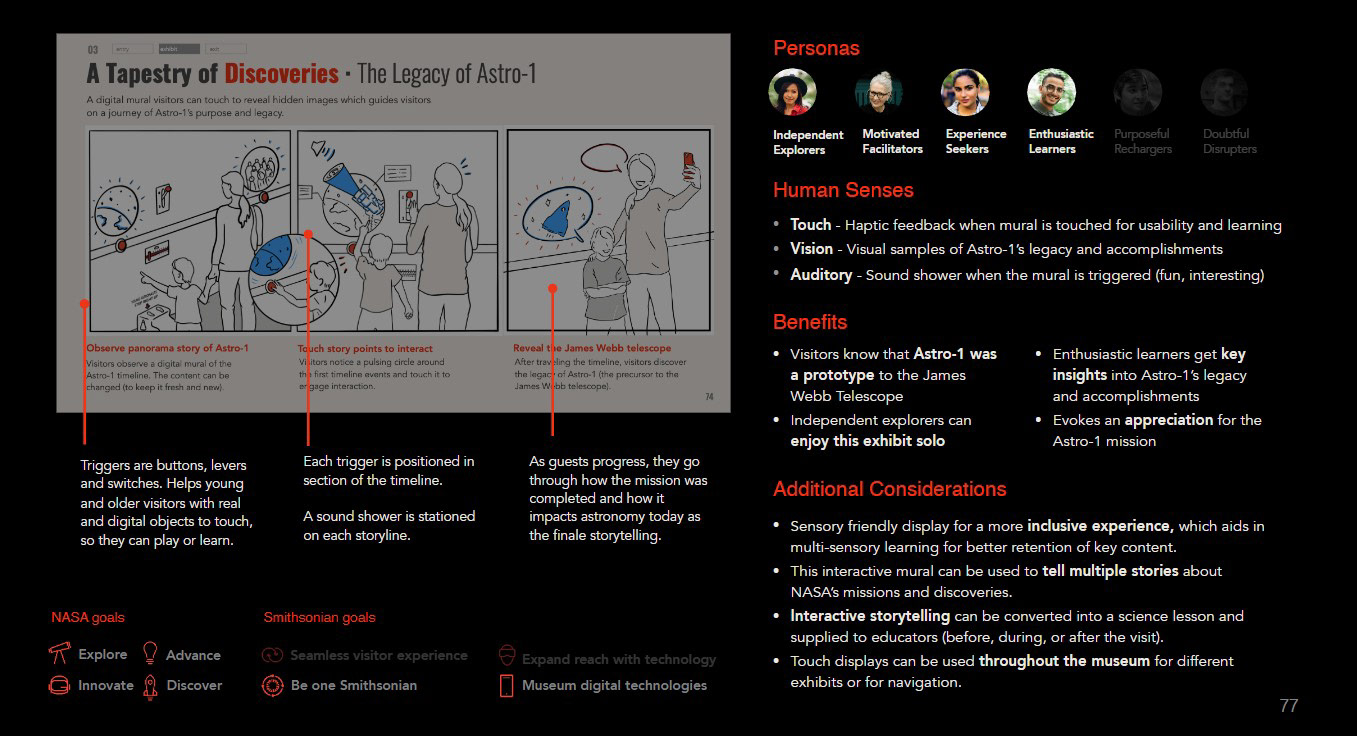
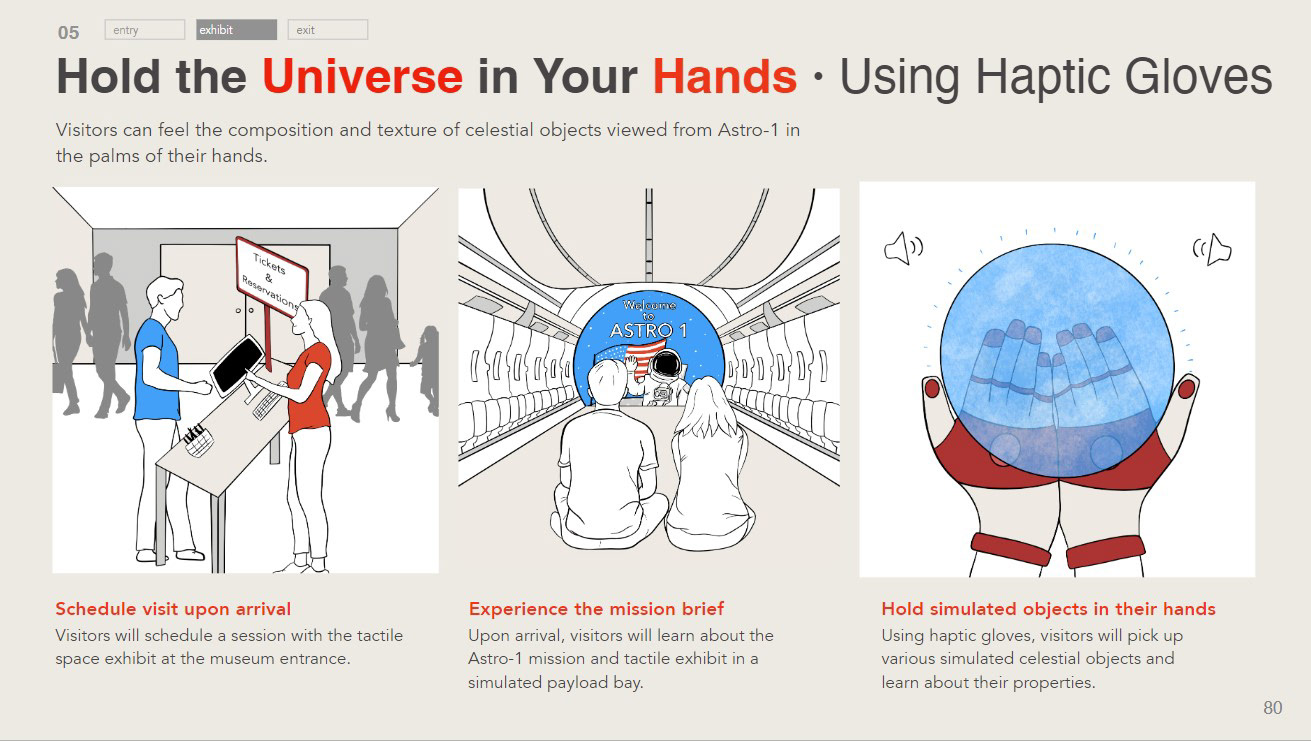

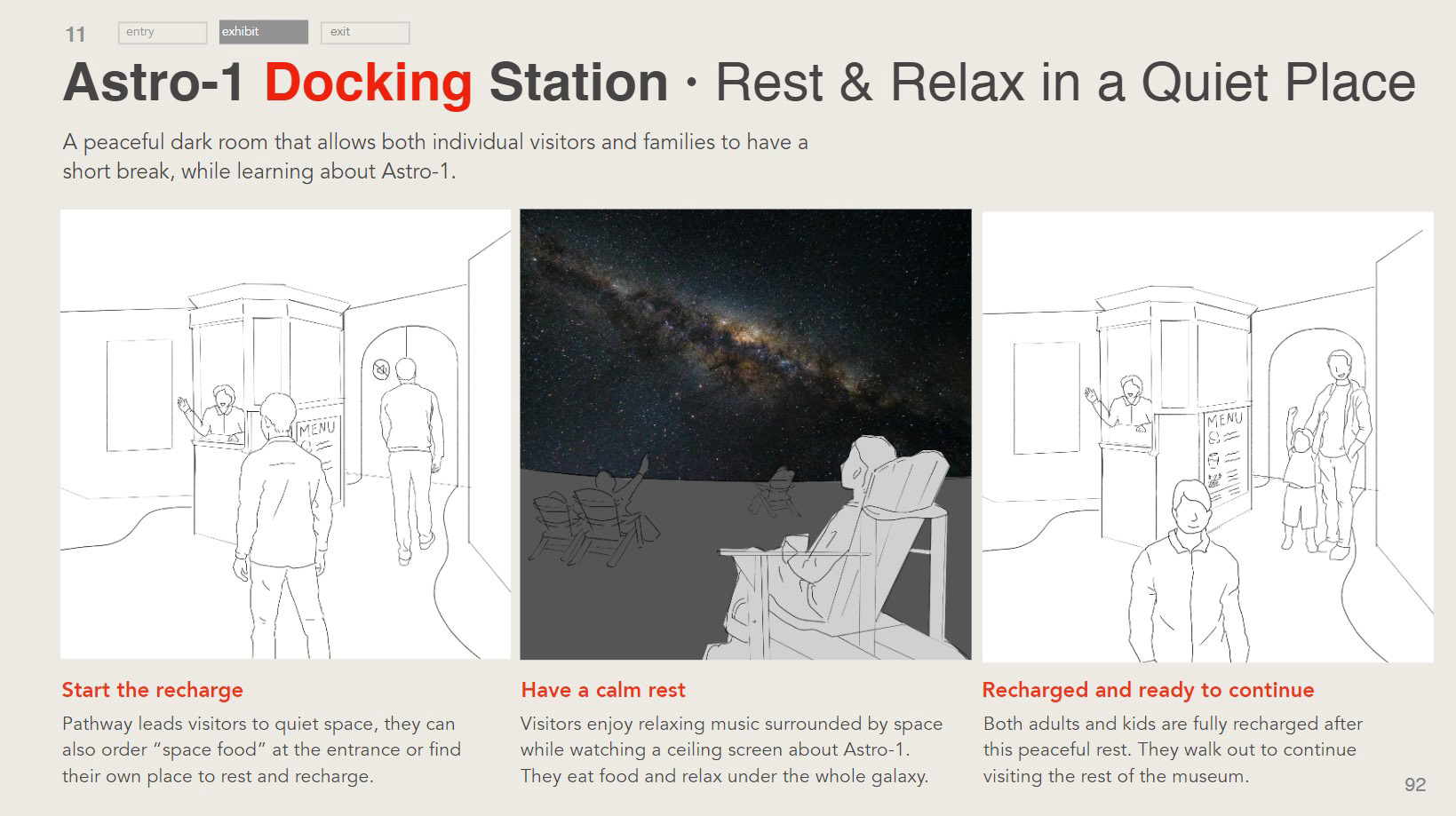

4. Exclusives & Lessons Learned
Future Vision
Review: Obtain feedback on our current storyboards. Refine the storyboards.
Commit: Work with stakeholders on identifying and finalizing future actions.
Develop: Establish research and development teams who might iterate on the exhibit.
What I Learned From This Project
Adaptability and Proactive Communication Amid Change: In this project, adaptability was key. Plans shifted quickly, teaching me the importance of proactive communication and collaboration amid unforeseen changes.
Connecting Research to Project Implications: During our research phase, Professor Cassini posed a crucial question: "What are the implications of your research?" It dawned on us that despite our thorough readings and interviews about Astro-1, we had yet to consider how they connected to our project and needed to articulate these implications in our presentation.
Fostering Professionalism Through Initiative: Professors Brian and Cassini encouraged us to carry ourselves as professionals rather than students by taking initiative. I took the initiative in various project tasks, from time-lapse videos to persona development and interviews.
